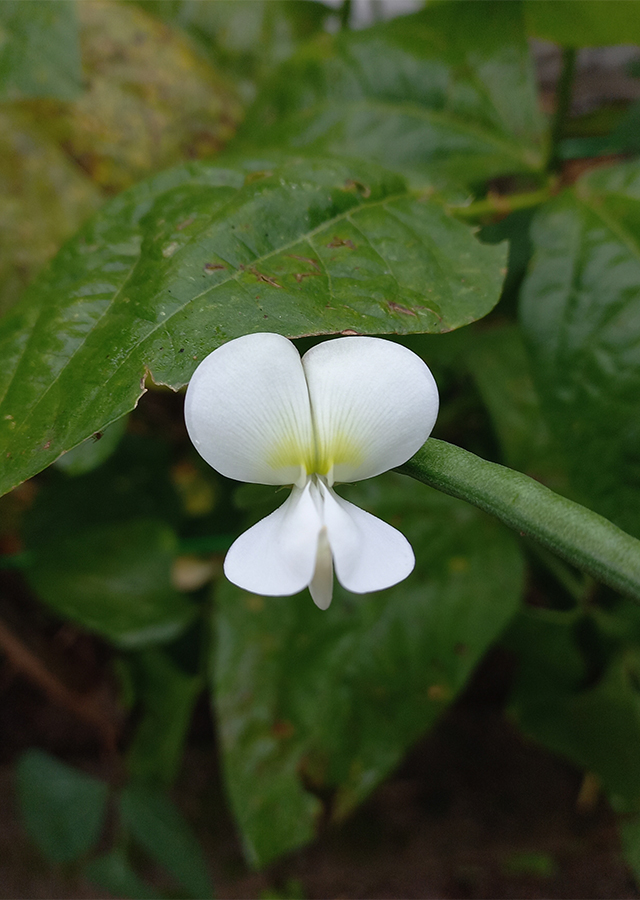Cowpea
Vigna unguiculata subsp. unguiculata (L.) Walp.
Fabaceae
Location in our garden
Vegetable



Synonym
Dolichos capitatus Wall.
Dolichos catjang L.
Dolichos catjang Burm.f.
Habitus
Herbaceous. An annual climbing plant growing up to 4 m tall.
Part Used
Leaves
Seeds
Roots
Growing Requirements
Full Sunshine
Need Shade
Habitat
Roadside
Shrublands
Terrestrial
Overview
Vigna unguiculata subsp. unguiculata is native to Cape Verde, tropical and South Africa. The plant is often cultivated for its edible seed. The immature seeds are used as a vegetable - they can be steamed, boiled, stir-fried etc. Mature seeds are added to soups and stews, ground into a powder and used with cereal flour for making cakes, bread etc. The roasted seed can be ground into a powder and used like coffee. The leaves can be cooked like spinach. The plant is also grown as a green manure.
Vernacular Names
Haricot indigène (French), Augenbohne (German), Costeño (Spanish), Hachigawa (Japanese), Ala-sandi (India), Kacang belut (Malaysia), Po-thoh-sa (Thai), Sandaek angkuy (Cambodian), Jiang dou (Chinese), Paayap (Tagalog-Philippines).
Agroecology
Found in open habitats, abandoned fields, and roadsides. A plant of the lowland tropics, where it can also be cultivated at elevations up to 1,500 m. It grows best in areas where annual daytime temperatures are within the range 20-35 °C, but can tolerate 10-40 °C.The plant cannot tolerate frost It prefers a mean annual rainfall in the range 600-1,500 mm, but tolerates 400-4,100 mm. Prefers a position in full sun, tolerating light shade. Succeeds in a wide variety of soils, from sandy loams to clays, so long as they are well-drained. Prefers a pH in the range 5.5-7.5, tolerating 4.3-8.8. Good yields have been obtained on peaty soils, but the plant dislikes alkaline soils since this reduces nodulation of bacteria on the roots and causes chlorosis of the leaves.
Morphology
- Stem - twining, upright stems are hollow and hairless, about 1 cm wide.
- Leaves - trifoliate, 2.5 to 12.5 cm long. Two lateral leaves are asymmetrical. Central leaflet is hastate, symmetrical, smooth, with the lateral surfaces irregular.
- Flowers - in axillary racemes on stalks 15 to 30 cm long.
- Fruit - pods are pendulous, smooth, 10 to 22 cm long with a thick decurved beak and 10- to 15-seeded.
- Seeds - 4 to 8 mm long, 3 to 4 mm wide, variable in size and colour.
Cultivation
Generatively propagated by seed - pre-soak for 12 hours in warm water and sow 1-3 cm deep in situ. The seed germinates best when the soil temperature is above 21 °C.
Chemical Constituents
Triterpenoid, saponin (vignalin), cycloartenol, stigmasterol, oleanolic acid acetate, sitosterol ß-D-glycoside, glycosides, tannins, flavonoids, saponin glycosides, sterols, alkaloids, oct-2-ene, nona-3,5-diene, non-4-ene, octadecanoic acid, hexadecanoic acid.
Traditional Medicinal Uses
- It is used in traditional medicine of Ayurveda, Shida and Unani.
- Leaves mild laxative, chewed to treat tooth ailments. The crushed leaves are used in a poultice to heal and bond broken bones.
- Leaves and seeds applied as a poultice in treat swellings and skin infections.
- Seed diuretic and stomachic for menstruation, epilepsy, and chest pains. Boiled seed eaten for kidney stone.
- Root an antidote for snake bites, constipation, and dysmenorrhea. Paste of root apllied to treat headache.
- Studies suggest antifungal, antiviral, anti-inflammatory, anti-sickling, cardioprotective, thrombolytic, antidiabetic, hypolipidemic, diuretic, anti-atherosclerotic, anthelmintic, antimicrobial, membrane stabilizing, antiobesity, anticancer, antidepressant properties.
Part Used
Reference Sources
- Fern, Ken. (2021). Useful Tropical Plants: Vigna unguiculata unguiculata. https://tropical.theferns.info/viewtropical.php?id=Vigna+unguiculata+unguiculata. 06-01-2021.
- Kew Royal Botanic Gardens. (No date). Plants Of The World Online: Vigna unguiculata subsp. unguiculata. https://powo.science.kew.org/taxon/urn:lsid:ipni.org:names:101661-3. 06-01-2021.
- Stuartxchange. (2021). Philippine Medicinal Plants: Paayap. http://www.stuartxchange.com/Paayap.html. 06-01-2022.
- UPOV. (2011). Vigna unguiculata (L.) Walp. subsp. unguiculata (VIGNA_UNG_UNG). https://www.upov.int/genie/en/details.xhtml?cropId=5882. 06-01-2021.
- Umberto Quattraocchi, F.L.S. 2012. CRC World Dictionary of Medicinal and Poisonous Plants. Common name, Scientific Name, Eponyms, Synonyms and etymology. CRC Press Taylor & Francis Group, LLC. United States. https://www.google.co.id/books/edition/CRC_World_Dictionary_of_Medicinal_and_Po/-37OBQAAQBAJ?hl=id&gbpv=1&dq=vigna+unguiculata+subsp.+unguiculata&pg=PA3908&printsec=frontcover. 06-01-2021.


